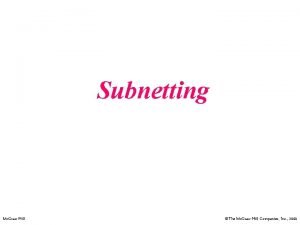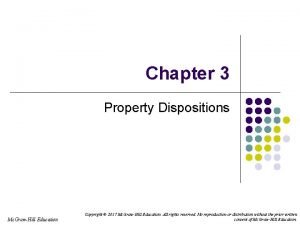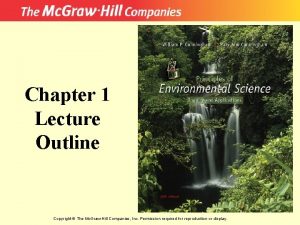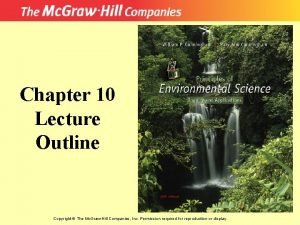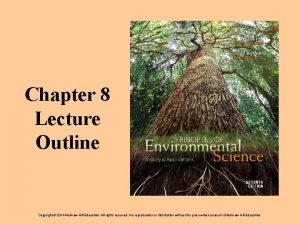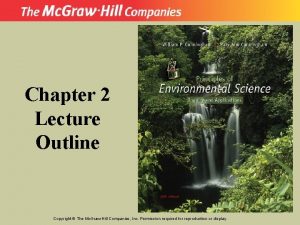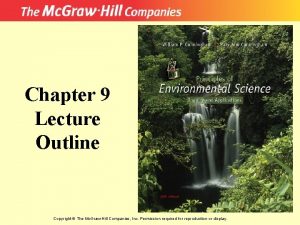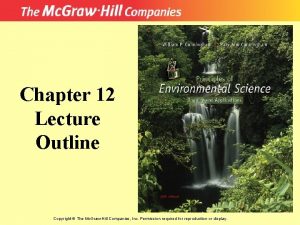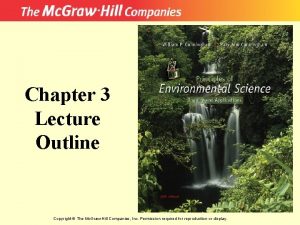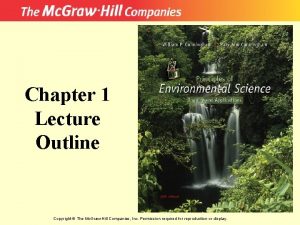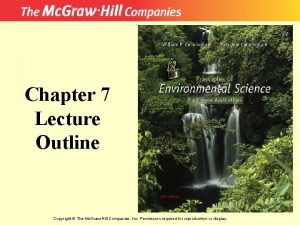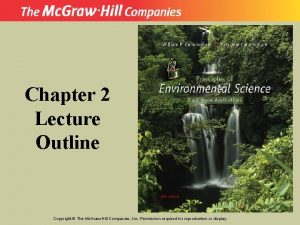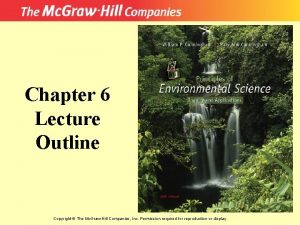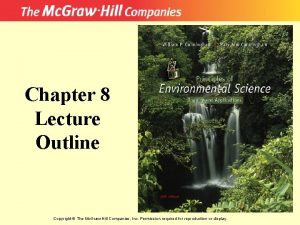Chapter 5 Lecture Outline Copyright The Mc GrawHill









































- Slides: 41

Chapter 5 Lecture Outline Copyright © The Mc. Graw-Hill Companies, Inc. Permission required for reproduction or display.

Learning Outcomes After studying this chapter, you should be able to answer the following questions: • What are nine major terrestrial biomes, and what environmental conditions control their distribution? • How does vertical stratification differentiate life zones in oceans? • Why are coral reefs, mangroves, estuaries, and wetlands biologically important? • What do we mean by biodiversity? List several regions of high biodiversity. • What are four major benefits of biodiversity? • What are the major human-caused threats to biodiversity? • How can we reduce these threats to biodiversity? 5 -2

In the end, we conserve only what we love. We will love only what we understand. We will understand only what we are taught. –Baba Dioum 5 -3

5. 1 Terrestrial Biomes • Biodiversity-the number and variety of species. • Biomes-broad types of biological communities with characteristic types of environments that occur in different conditions of temperature and precipitation. 5 -4

Figure 5. 3 Biomes most likely to occur in the absence of human disturbance or other disruptions, according to average annual temperature and precipitation. Note: This diagram does not consider soil type, topography, wind speed, or other important environmental factors. Still, it is a useful general guideline for biome location. Source: Whitaker, Robert, C. , Communities & Ecosystems, 2 e. © 1975. Adapted by permission of Pearson Education, Inc. , Upper Saddle River, NJ. 5 -5

5 -6

• Vertical zonation is a term applied to vegetation zones defined by altitude. 5 -7

Annual temperature and precipitation levels in terrestrial biomes 5 -8

Tropical rainforests • Tropical rainforests occur where rainfall is abundant— more than 200 cm (80 in. ) per year—and temperatures are warm to hot year-round 5 -9

Tropical savannas and grasslands are dry most of the year • Where there is too little rainfall to support forests, we find open grasslands or grasslands with sparse tree cover, which we call savannas. 5 -10

Deserts are hot or cold, but always dry • Deserts occur where precipitation is uncommon and slight, usually with less than 5 -11

Temperate grasslands have rich soils • As in tropical latitudes, temperate (midlatitude) grasslands occur where there is enough rain to support abundant grass but not enough forests 5 -12

Temperate forests can be evergreen or deciduous • These forests by are grouped by tree type, broad-leaved deciduous (losing leaves seasonally) or evergreen coniferous (conebearing). 5 -13

Temperate rainforests • The coniferous forests of the Pacific coast grow in extremely wet conditions. The wettest coastal forests are known as temperate rainforest, a cool, rainy forest often enshrouded in fog. 5 -14

Boreal forests lie north of the temperate zone 5 -15

Tundra can freeze in any month • Compared to other biomes, tundra has relatively low diversity. 5 -16

5. 2 Marine Ecosystems • Most marine communities depend on photosynthetic organisms. • Phytoplankton: algae or tiny, free-floating photosynthetic plants that often support a marine food web. 5 -17

5 -18 Open ocean communities vary from surface to hadal zone

Tidal shores support rich, diverse communities Coral reefs are among the best-known marine systems, because of their extraordinary biological productivity and their diverse and beautiful organisms 5 -19

Tidal shores continued: Mangroves are a diverse group of salt-tolerant trees that grow along warm, calm marine coasts around the world 5 -20

Tidal shores continued: Estuaries & Salt Marshes Estuaries are bays where rivers empty into the sea, mixing fresh water with salt water. Salt marshes, shallow wetlands flooded regularly or occasionally with seawater, occur on 5 -21 shallow coastlines, including estuaries

Tidal shores continued: Tide pools are depressions in a rocky shoreline that are flooded at high tide but retain some water at low tide. 5 -22

5. 3 Freshwater Ecosystems: Lakes 5 -23

Freshwater Ecosystems continued: Wetlands (swamps, marshes, & bogs) are shallow ecosystems in which the land surface is saturated or submerged at least part of the year. 5 -24

Freshwater Ecosystems continued: Streams & Rivers • Streams form wherever precipitation exceeds evaporation and surplus water drains from the land. • As streams collect water and merge, they form rivers. 5 -25

5. 4 Biodiversity • Biodiversity, the variety of living things. • Three kinds of biodiversity are essential to preserve ecological systems and functions: – genetic diversity is a measure of the variety of versions of the same genes within individual species – species diversity describes the number of different kinds of organisms within a community or ecosystem – ecological diversity means the richness and complexity of a biological community 5 -26

Increasingly, we identify species by genetic similarity • Species are distinct organisms that persist because they can produce fertile offspring. • The phylogenetic species concept, which identifies genetic similarity, allows for asexual organisms and sexually reproducing ones that don’t normally encounter each other. 5 -27

Biodiversity hot spots are rich and threatened 5 -28

5. 5 Benefits of Biodiversity • All of our food comes from other organisms – Many wild plant species could make important contributions to human food supplies. • Rare species provide important medicines – More than half of all prescriptions contain some natural products. • Biodiversity can support ecosystem stability • Biodiversity has aesthetic and cultural benefits 5 -29

5. 6 What Threatens Biodiversity? • Extinction, the elimination of a species, is a normal process of the natural world. • Threats to biodiversity: – – – – Habitat destruction is the main threat Fragmentation reduces habitat to small, isolated patches Invasive species are a growing threat Pollution poses many different types of risk Human population growth Overharvesting & commercial collection Predator and pest control 5 -30

5. 7 Endangered Species Management and Biodiversity Protection • Hunting and fishing laws protect reproductive populations • The endangered species act protects habitat and species 5 -31

Endangered species act terminology • Endangered species are those considered in imminent danger of extinction • Threatened species are likely to become endangered, at least locally within the forseeable future. • Vulnerable species are naturally rare or have been locally depleted by human activities to a level that puts them at risk. 5 -32

Species Terminology • Keystone species are those with major effects on ecological functions and whose elimination would affect many other members of the biological community. • Indicator species are those tied to specific biotic communities or successional stages or environmental conditions. 5 -33

Species Terminology continued… • Umbrella species require large blocks of relatively undisturbed habitat to maintain viable populations. • Flagship species are especially interesting or attractive organisms to which people react emotionally. 5 -34

Controversy persists in species protection: • In 1995 the Supreme Court ruled that critical habitat—habitat essential for a species’ survival—must be protected, whether on public or private land. • An important test of the ESA occurred in 1978 in Tennessee, when construction of the Tellico Dam threatened a tiny fish called the snail darter. 5 -35

5 -36

Many countries have laws for species protection • Canada’s Committee on the Status of Endangered Wildlife in Canada (COSEWIC) of 1977 establishes rules for listing and protecting endangered species. • The European Union’s Birds Directive (1979) and Habitat Directive (1991). • Australia’s Endangered Species Protection Act (1992). • The Convention on Biological Diversity (1992) is an International agreement. • The Convention on International Trade in Endangered Species (CITES) of 1975. 5 -37

Habitat protection may be better than species protection • By focusing on populations already reduced to only a few individuals, we spend most of our conservation funds on species that may be genetically doomed no matter what we do. • It is time to focus on a rational, continent-wide preservation of ecosystems that supports maximum biological diversity rather than a species-by-species battle for the rarest or most popular organisms. 5 -38

Practice Quiz 1. Why did ecologists want to reintroduce wolves to Yellowstone Park? What goals did they have, and have their goals been achieved? 2. Describe nine major types of terrestrial biomes. 3. Explain how climate graphs (as in fig. 5. 6) should be read. 4. Describe conditions under which coral reefs, mangroves, estuaries, and tide pools occur. 5. Throughout the central portion of North America is a large biome once dominated by grasses. Describe how physical conditions and other factors control this biome. 5 -39

Practice Quiz continued… 6. Explain the difference between swamps, marshes, and bogs. 7. How do elevation (on mountains) and depth (in water) affect environmental conditions and life-forms? 8. Figure 5. 15 shows chlorophyll (plant growth) in oceans and on land. Explain why green, photosynthesizing organisms occur in long bands at the equator and along the edges of continents. Explain the very dark green areas and yellow/ orange areas on the continents. 9. Define biodiversity and give three types of biodiversity essential in preserving ecological systems and functions. 5 -40

Practice Quiz continued… 10. What is a biodiversity “hot spot”? List several of them (see fig. 5. 22). 11. How do humans benefit from biodiversity? 12. What does the acronym HIPPO refer to? 13. Have extinctions occurred in the past? Is there anything unusual about current extinctions? 14. Why are exotic or invasive species a threat to biodiversity? Give several examples of exotic invasive species (see fig. 5. 27). 15. What is the Endangered Species Act? Describe some of the main arguments of its proponents and opponents. 16. What is a flagship or umbrella species? Why are they often important, even though they are costly to maintain? 5 -41
 Grawhill
Grawhill Grawhill
Grawhill Grawhill
Grawhill Grawhill
Grawhill Mc grawhill
Mc grawhill Mc grawhill
Mc grawhill Grawhill
Grawhill Mc grawhill
Mc grawhill Grawhill
Grawhill 01:640:244 lecture notes - lecture 15: plat, idah, farad
01:640:244 lecture notes - lecture 15: plat, idah, farad Lecture outline example
Lecture outline example Lecture outline example
Lecture outline example Lecture outline example
Lecture outline example Lecture outline meaning
Lecture outline meaning Sandwich quotation
Sandwich quotation Hát kết hợp bộ gõ cơ thể
Hát kết hợp bộ gõ cơ thể Ng-html
Ng-html Bổ thể
Bổ thể Tỉ lệ cơ thể trẻ em
Tỉ lệ cơ thể trẻ em Chó sói
Chó sói Thang điểm glasgow
Thang điểm glasgow Chúa yêu trần thế alleluia
Chúa yêu trần thế alleluia Các môn thể thao bắt đầu bằng tiếng đua
Các môn thể thao bắt đầu bằng tiếng đua Thế nào là hệ số cao nhất
Thế nào là hệ số cao nhất Các châu lục và đại dương trên thế giới
Các châu lục và đại dương trên thế giới Cong thức tính động năng
Cong thức tính động năng Trời xanh đây là của chúng ta thể thơ
Trời xanh đây là của chúng ta thể thơ Mật thư tọa độ 5x5
Mật thư tọa độ 5x5 Phép trừ bù
Phép trừ bù Phản ứng thế ankan
Phản ứng thế ankan Các châu lục và đại dương trên thế giới
Các châu lục và đại dương trên thế giới Thơ thất ngôn tứ tuyệt đường luật
Thơ thất ngôn tứ tuyệt đường luật Quá trình desamine hóa có thể tạo ra
Quá trình desamine hóa có thể tạo ra Một số thể thơ truyền thống
Một số thể thơ truyền thống Cái miệng xinh xinh thế chỉ nói điều hay thôi
Cái miệng xinh xinh thế chỉ nói điều hay thôi Vẽ hình chiếu vuông góc của vật thể sau
Vẽ hình chiếu vuông góc của vật thể sau Nguyên nhân của sự mỏi cơ sinh 8
Nguyên nhân của sự mỏi cơ sinh 8 đặc điểm cơ thể của người tối cổ
đặc điểm cơ thể của người tối cổ V cc cc
V cc cc Vẽ hình chiếu đứng bằng cạnh của vật thể
Vẽ hình chiếu đứng bằng cạnh của vật thể Vẽ hình chiếu vuông góc của vật thể sau
Vẽ hình chiếu vuông góc của vật thể sau Thẻ vin
Thẻ vin



